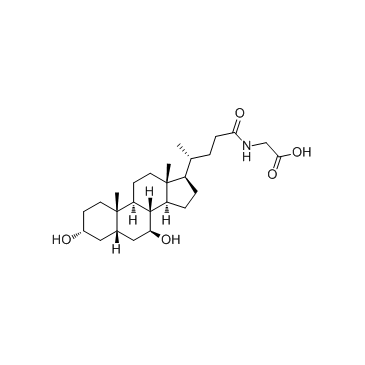Glycoursodeoxycholic acid

Glycoursodeoxycholic acid structure
|
Common Name | Glycoursodeoxycholic acid | ||
|---|---|---|---|---|
| CAS Number | 64480-66-6 | Molecular Weight | 449.62300 | |
| Density | N/A | Boiling Point | N/A | |
| Molecular Formula | C26H43NO5 | Melting Point | 232-235ºC | |
| MSDS | Chinese USA | Flash Point | N/A | |
|
Ultra high resolution SFC-MS as a high throughput platform for metabolic phenotyping: application to metabolic profiling of rat and dog bile.
J. Chromatogr. B. Analyt. Technol. Biomed. Life Sci. 966 , 200-7, (2014) Ultra high resolution SFC-MS (on sub-2μm particles) coupled to mass spectrometry has been evaluated for the metabolic profiling of rat and dog bile. The selectivity of the SFC separation differed from that seen in previous reversed-phase UPLC-MS studies on bi... |
|
|
A possible role of chenodeoxycholic acid and glycine-conjugated bile acids in fibrotic steatohepatitis in a dietary rat model.
Dig. Dis. Sci. 59(7) , 1490-501, (2014) Our previous study indicated that hepatic bile acids (BAs) may have deposited and stimulated the pathogenesis of a high fat-cholesterol (HFC) diet-induced fibrotic steatohepatitis in stroke-prone spontaneously hypertensive 5/Dmcr rats, based on dysregulated B... |
|
|
A liquid chromatography-tandem mass spectrometry-based method for the simultaneous determination of hydroxy sterols and bile acids.
J. Chromatogr. A. 1371 , 184-95, (2014) Recently, hydroxy sterols and bile acids have gained growing interest as they are important regulators of energy homoeostasis and inflammation. The high number of different hydroxy sterols and bile acid species requires powerful analytical tools to quantify t... |
|
|
Profile of bile acids in fetal gallbladder and meconium using liquid chromatography-tandem mass spectrometry.
Clin. Chim. Acta 446 , 76-81, (2015) The primary bile acids found in meconium vary with the gestational age of the fetus and the intestinal location of the meconium. We determined the composition of bile acids in samples that were collected from the gallbladder and intestine.The bile-acid profil... |
|
|
Novel potent and selective bile acid derivatives as TGR5 agonists: biological screening, structure-activity relationships, and molecular modeling studies.
J. Med. Chem. 51 , 1831-41, (2008) TGR5, a metabotropic receptor that is G-protein-coupled to the induction of adenylate cyclase, has been recognized as the molecular link connecting bile acids to the control of energy and glucose homeostasis. With the aim of disclosing novel selective modulat... |
|
|
Matrix effects break the LC behavior rule for analytes in LC-MS/MS analysis of biological samples.
Exp. Biol. Med. (Maywood.) 240(4) , 488-97, (2015) High-performance liquid chromatography (HPLC) and liquid chromatography-tandem mass spectrometry (LC-MS/MS) are generally accepted as the preferred techniques for detecting and quantitating analytes of interest in biological matrices on the basis of the rule ... |
|
|
Metabolomics reveals novel biomarkers of illegal 5-nitromimidazole treatment in pigs. Further evidence of drug toxicity uncovered.
Food Chem. 199 , 876-84, (2016) The aim of the study was to investigate the potential of a metabolomics platform to distinguish between pigs treated with ronidazole, dimetridazole and metronidazole and non-medicated animals (controls), at two withdrawal periods (day 0 and 5). Livers from ea... |
|
|
Bile acids induce hepatic differentiation of mesenchymal stem cells.
Sci. Rep. 5 , 13320, (2015) Mesenchymal stem cells (MSC) have the potential to differentiate into multiple cell lineages and their therapeutic potential has become obvious. In the liver, MSC are represented by stellate cells which have the potential to differentiate into hepatocytes aft... |
|
|
Plasma phospholipids identify antecedent memory impairment in older adults.
Nat. Med. 20(4) , 415-8, (2014) Alzheimer's disease causes a progressive dementia that currently affects over 35 million individuals worldwide and is expected to affect 115 million by 2050 (ref. 1). There are no cures or disease-modifying therapies, and this may be due to our inability to d... |
|
|
Bile acid toxicity structure-activity relationships: correlations between cell viability and lipophilicity in a panel of new and known bile acids using an oesophageal cell line (HET-1A).
Bioorg. Med. Chem. 18 , 6886-95, (2010) The molecular mechanisms and interactions underlying bile acid cytotoxicity are important to understand for intestinal and hepatic disease treatment and prevention and the design of bile acid-based therapeutics. Bile acid lipophilicity is believed to be an im... |